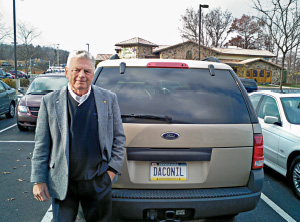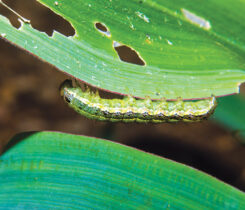Taking action: How Daconil shaped Lee Kozsey’s career
Imagine being present at the “aha!” moment when fiberglass woods were dreamed up. Or when the internet was invented. Or, if you’re Lee Kozsey, when Daconil fungicide was in its first days.
“It’s been exciting,” Kozsey says. “Daconil has been the mainstay in my life for almost 50 years.”
“Customers can use Lee’s history to understand the whole chlorothalonil franchise,” says Bob Goglia, Daconil brand manager with Syngenta. “Lee worked with it when there wasn’t a professional division. He worked with it in multiple markets like potatoes and other crops, as well as turf and ornamentals.”
Diamond Alkali Co. was the outfit that developed Daconil (*see bottom of page). Kozsey worked with the product as it passed through many firms, including Diamond-Shamrock, SDS Biotech, Fermenta Plant Protection, ISK Biosciences, Zeneca and eventually Syngenta.
“I tease him telling him that he’s the only guy I know who has worked for nine companies but has never had to submit a resume,” Goglia laughs.
How dedicated to Daconil is Kozsey? His truck has personalized “Daconil” vanity plates. Last year he celebrated 50 years shepherding Daconil for Syngenta and its legacy
companies.
“Dr. Robert Batershell developed the molecule in 1961,” recalls Kozsey, who was asked to work on a “special project.” Little did he imagine that it would become his life’s work. Diamond Alkali specialized in products such as chlorine, soda ash and cement. “At that time, most plant protection products were in the chlorinated hydrocarbon family,” Kozsey points out.
Although agriculture was the big market for plant materials, golf was in Daconil fungicide’s DNA from the get-go. The lab where Kozsey and Batershell worked was in Concord, Ohio, across from Quail Hollow Country Club. Some of the basic field testing was done with Al Brotzman at the Erie Shores Golf Course in Madison, Ohio. The first approval for the product’s use was for turf, not agriculture.
In 1963, in Lab 13, a six-person team, including Kozsey (whose formal turf education is based mainly on short courses at Purdue, Ohio State and Florida) was trying to make the material in large quantities. They used a one-foot-long capillary tube and figured how to make the basic material. They graduated to a two-foot reactor to produce material for a worldwide screening of Daconil. Soon they graduated to a 10-foot reactor.
Daconil was produced at the research site until after it had produced 100,000 pounds of material. By 1973, production moved to Greens Bayou, Texas, where it is still made today.
Kozsey moved out to the Research Farm in Ohio in 1967 and in 1984 was transferred to Naples, Florida, to manage the research farm there. He moved up to Pennsylvania in 1988 when the farm was sold and eventually went into sales. As the product was sold from firm to firm, it eventually found a home with Zeneca. “They had Heritage fungicide — Heritage and Daconil were complementary to one another,” he notes. “I was fortunate enough to make the cut when Syngenta was formed,” he says.
Looking forward
Kozsey says he “absolutely” would encourage any young person to get into the Green Industry. “Improving plant health, yields on crops, turf… these needs will be here forever. We need green. Without scientists helping develop things to make life better in the plant world, we could be lost.”
When he plays Canterbury Golf Club in Cleveland with his grandsons, he points out the Poa, the bentgrass, and other things. “It is important to know what’s going on below your feet,” he says.
Kozsey says, “Whether a youth goes into the turf business as a scientist or marketer, it is important to deliver the best product you can. Do something that will improve the situation,” he adds.
“You have to think ahead. We have problems out there,” Kozsey continues. For example, he notes that people used to think Poa died because it is an annual grass. But after years of research, it was discovered that it in fact gets a disease called summer patch.“You have to get out there, get involved a little deeper in things to correct them. The challenge to young people is to get into things and to research them more,” he urges.
“We’re continually trying to improve the product line to suppress or control dollar spot and other diseases a bit more so they do not take out the turf,” he says. “We’re always trying to drop a new engine under the old hood,” Kozsey chuckles.
The average superintendent is 37 years old and was not working prior to 1996. They don’t know a world before Daconil Ultrex and Daconil Weather Stik. “If you asked most of them, they would think that those were the original formulations,” Goglia says.
The latest performance boost for golf turf is Daconil Action fungicide — a combination of Daconil with plant activator Acibenzolar-S-methyl (also known as acibenzolar). The result is a product that gives turf an extra protein boost to help defend itself against diseases.
“Lee was specifically put on the launch team for Daconil Action because of his history and knowledge base,” Goglia notes. “He was critical in helping the development of the product positioning and how we launched it.”
Kozsey’s wife, Lucille, has been supportive of his long career. She says it makes him happy and proud. It’s not all work, though. Kozsey is a solid golfer and competes in an amateur tournament every year in Pennsylvania.
“The turfgrass industry is a great industry. People enjoy turf. It is necessary. God gave turf to us and we have to be good stewards,” Kozsey says. Superintendents used to be called greenskeepers, Kozsey says. Now, he says they are environmental managers who produce a good product while managing inputs and water usage along with course membership needs and members’ expectations.
And, for a half-century, Lee Kozsey has been a key part of that progress.
*WHY DACONIL-2787?
For 40-plus years, superintendents have applied Daconil fungicide to their turf. But we’re willing to bet that you don’t know why the compound is called Daconil-2787.
The DAC part comes from the original developing company’s name: Diamond Alkali Co. The ONIL is from the end of the technical name of the product: chlorothalonil. The 2787 simply means it was the 2787th molecule the lab made.











